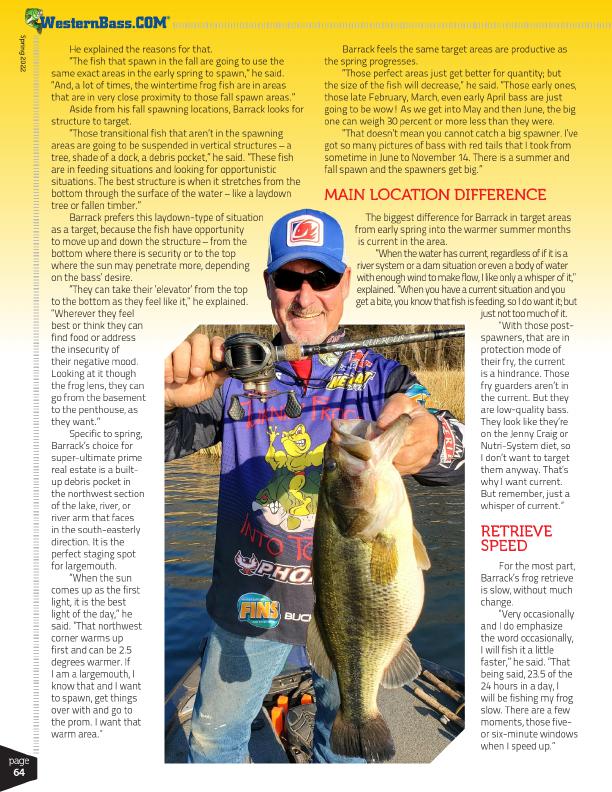
®
Spring 2022
page 64
He explained the reasons for that.
“The fish that spawn in the fall are going to use the same exact areas in the early spring to spawn,” he said. “And, a lot of times, the wintertime frog fish are in areas that are in very close proximity to those fall spawn areas.”
Aside from his fall spawning locations, Barrack looks for structure to target.
“Those transitional fish that aren’t in the spawning areas are going to be suspended in vertical structures – a tree, shade of a dock, a debris pocket,” he said. “These fish are in feeding situations and looking for opportunistic situations. The best structure is when it stretches from the bottom through the surface of the water – like a laydown tree or fallen timber.”
Barrack prefers this laydown-type of situation as a target, because the fish have opportunity to move up and down the structure – from the bottom where there is security or to the top where the sun may penetrate more, depending on the bass’ desire.
“They can take their ‘elevator’ from the top to the bottom as they feel like it,” he explained. “Wherever they feel best or think they can find food or address the insecurity of their negative mood. Looking at it though the frog lens, they can go from the basement to the penthouse, as they want.”
Specific to spring, Barrack’s choice for super-ultimate prime real estate is a built- up debris pocket in the northwest section of the lake, river, or river arm that faces in the south-easterly direction. It is the perfect staging spot for largemouth.
“When the sun comes up as the first light, it is the best light of the day,” he said. “That northwest corner warms up first and can be 2.5 degrees warmer. If I am a largemouth, I know that and I want to spawn, get things over with and go to the prom. I want that warm area.”
Barrack feels the same target areas are productive as the spring progresses.
“Those perfect areas just get better for quantity; but the size of the fish will decrease,” he said. “Those early ones, those late February, March, even early April bass are just going to be wow! As we get into May and then June, the big one can weigh 30 percent or more less than they were.
“That doesn’t mean you cannot catch a big spawner. I’ve got so many pictures of bass with red tails that I took from sometime in June to November 14. There is a summer and fall spawn and the spawners get big.”
MAIN LOCATION DIFFERENCE
The biggest difference for Barrack in target areas from early spring into the warmer summer months is current in the area.
“When the water has current, regardless of if it is a river system or a dam situation or even a body of water with enough wind to make flow, I like only a whisper of it,” explained. “When you have a current situation and you get a bite, you know that fish is feeding, so I do want it; but
just not too much of it.
“With those post-
spawners, that are in
protection mode of
their fry, the current
is a hindrance. Those
fry guarders aren’t in
the current. But they
are low-quality bass.
They look like they’re
on the Jenny Craig or
Nutri-System diet, so
I don’t want to target
them anyway. That’s
why I want current.
But remember, just a
whisper of current.”
RETRIEVE SPEED
For the most part, Barrack’s frog retrieve is slow, without much change.
“Very occasionally and I do emphasize the word occasionally, I will fish it a little faster,” he said. “That being said, 23.5 of the 24 hours in a day, I will be fishing my frog slow. There are a few moments, those five- or six-minute windows when I speed up.”